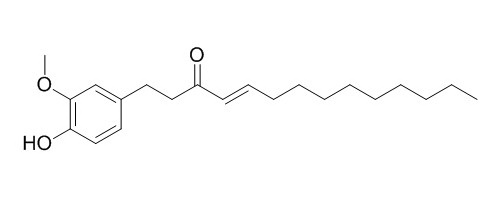10-Shogaol
10-Shogaol, as an antioxidant for human skin cell growth and a migration enhancer with potential to be a novel wound repair agent.8- and 10-Shogaol have similar metabolic profiles to [6]-shogaol and exhibit similar toxicity toward human colon cancer cells.
Inquire / Order:
manager@chemfaces.com
Technical Inquiries:
service@chemfaces.com
Tel:
+86-27-84237783
Fax:
+86-27-84254680
Address:
1 Building, No. 83, CheCheng Rd., Wuhan Economic and Technological Development Zone, Wuhan, Hubei 430056, PRC
Providing storage is as stated on the product vial and the vial is kept tightly sealed, the product can be stored for up to
24 months(2-8C).
Wherever possible, you should prepare and use solutions on the same day. However, if you need to make up stock solutions in advance, we recommend that you store the solution as aliquots in tightly sealed vials at -20C. Generally, these will be useable for up to two weeks. Before use, and prior to opening the vial we recommend that you allow your product to equilibrate to room temperature for at least 1 hour.
Need more advice on solubility, usage and handling? Please email to: service@chemfaces.com
The packaging of the product may have turned upside down during transportation, resulting in the natural compounds adhering to the neck or cap of the vial. take the vial out of its packaging and gently shake to let the compounds fall to the bottom of the vial. for liquid products, centrifuge at 200-500 RPM to gather the liquid at the bottom of the vial. try to avoid loss or contamination during handling.
Molecules.2020, 25(7):1625.
Sci Rep.2019, 9(1):6429
Biomol Ther (Seoul).2024, 32(5):546-555.
Plants (Basel).2020, 9(11):1535.
Evid Based Complement Alternat Med.2020, 2020:1970349.
African J. Agricultural Research 2017, 12(13):1164-1168
Int J Mol Sci.2023, 24(3):2102.
The Korea Journal of Herbology2016, 29-35
Br J Pharmacol.2024, 181(24):5009-5027.
Food Chem.2023, 404(Pt A):134517.
Related and Featured Products
Int J Mol Sci. 2012;13(2):1762-77.
10-Shogaol, an antioxidant from Zingiber officinale for skin cell proliferation and migration enhancer.[Pubmed:
22408422]
METHODS AND RESULTS:
In this work, one of Zingiber officinale components, 10-Shogaol, was tested with 1,1-diphenyl-2-picrylhydrazyl (DPPH) radical scavenging, metal chelating ability, and reducing power to show antioxidant activity. 10-Shogaol promoted human normal epidermal keratinocytes and dermal fibroblasts cell growths. 10-Shogaol enhanced growth factor production in transforming growth factor-β (TGF-β), platelet derived growth factor-αβ (PDGF-αβ) and vascular endothelial growth factors (VEGF) of both cells. In the in vitro wound healing assay for 12 or 24 h, with 10-Shogaol, the fibroblasts and keratinocytes migrated more rapidly than the vehicle control group.
CONCLUSIONS:
Thus, this study substantiates the target compound, 10-Shogaol, as an antioxidant for human skin cell growth and a migration enhancer with potential to be a novel wound repair agent.
J Agric Food Chem. 2014 May 21;62(20):4632-42.
Cysteine-conjugated metabolites of ginger components, shogaols, induce apoptosis through oxidative stress-mediated p53 pathway in human colon cancer cells.[Pubmed:
24786146]
Shogaols, the major constituents of thermally processed ginger, have been proven to be highly effective anticancer agents.
METHODS AND RESULTS:
Our group has identified cysteine-conjugated shogaols (M2, M2', and M2″) as the major metabolites of [6]-, [8]-, and 10-Shogaol in human and found that M2 is a carrier of its parent molecule [6]-shogaol in cancer cells and in mice, while being less toxic to normal colon fibroblast cells. The objectives of this study are to determine whether M2' and M2″ behave in a similar manner to M2, in both metabolism and efficacy as anticancer agents, and to further explore the biological pro-apoptotic mechanisms of the cysteine-conjugated shogaols against human colon cancer cells HCT-116 and HT-29.
CONCLUSIONS:
Our results show that [8]- and 10-Shogaol have similar metabolic profiles to [6]-shogaol and exhibit similar toxicity toward human colon cancer cells. A brief screen of the markers attenuated by the proapoptotic activity of M2 revealed similar results for [8]- and 10-Shogaol and their respective cysteine-conjugated metabolites M2' and M2″. This study highlights the cysteine-conjugated metabolites of shogaols as novel dietary colon cancer preventive agents.



